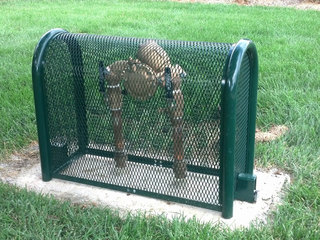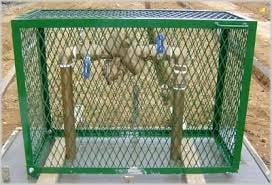This page will teach you everything you need to know about backflow cages and why they might not be the right fit for keeping backflow devices safe.
-
1Contact Information
-
2Additional Details
This page will teach you everything you need to know about backflow cages and why they might not be the right fit for keeping backflow devices safe.
 Backflow preventer enclosures come in a variety of materials all with various levels of protection. For backflow prevention devices 3" and smaller, it's common to see backflow cages. These cages are typically made of expanded metal and are relatively inexpensive to produce in small sizes, leading to their popularity protecting irrigation and sprinkler system backflow preventers.. Backflow protection cages are also popular in warmer climates like Arizona and California where there is thought to be minimal danger from freezing. Because they offer no freeze protection and can't be relied upon during the winter in most areas, the only places where cages could reasonably be considered are in the extreme American southwest. Wherever you may be, here's what you need to know about backflow cages.
Backflow preventer enclosures come in a variety of materials all with various levels of protection. For backflow prevention devices 3" and smaller, it's common to see backflow cages. These cages are typically made of expanded metal and are relatively inexpensive to produce in small sizes, leading to their popularity protecting irrigation and sprinkler system backflow preventers.. Backflow protection cages are also popular in warmer climates like Arizona and California where there is thought to be minimal danger from freezing. Because they offer no freeze protection and can't be relied upon during the winter in most areas, the only places where cages could reasonably be considered are in the extreme American southwest. Wherever you may be, here's what you need to know about backflow cages.
Protection: Cages have no insulation to provide frost or freeze protection, though we have seen them used in conjunction with insulated bags. They do provide some protection from vandalism, accidents or theft. They are typically made of powder-coated steel and include a locking mechanism.
Sizes (approximate): 24" x 24" to 60" x 60"
Colors: Typically green, metal and tan
Prices: $300 to $3,500 depending on size, style and features
Note: These are only able to be used in situations where the temperatures do not fall below 33°F as they cannot protect against frost or freezing. As mentioned above, they can be used in conjunction with an insulated bag. They are typically only sold for backflow assemblies 2" and smaller, although larger sizes are used in some areas.
Cages are designed to protect devices from theft and vandalism. Backflow valves are made of copper, brass or galvanized steel pipe. Backflow preventer theft, along with the theft of copper and other valuable metals, increased dramatically with the Great Recession and continues to happen today despite the lower market price of these materials. Areas that previously didn't need enclosures now did. Companies and municipalities had several options, and cages became a popular solution, since they didn't require freeze protection and typically came with a lower price tag, as opposed to aluminum or fiberglass enclosures. Multiple backflow cage manufacturers came on the scene and supplied the demand.
 Surprisingly, cages can be found in areas that do freeze regularly; we've seen them in places such as Denver, Colorado and throughout the Upper Midwest. It's not unusual to find irrigation backflow preventers from .75" to 4" in cages year-round. During colder months, they are often only wrapped in garbage bags.
Surprisingly, cages can be found in areas that do freeze regularly; we've seen them in places such as Denver, Colorado and throughout the Upper Midwest. It's not unusual to find irrigation backflow preventers from .75" to 4" in cages year-round. During colder months, they are often only wrapped in garbage bags.
Where the initial thrust behind cages' popularity was their value, the cost of manufacturing enclosures with other materials, such as fiberglass and aluminum, has come down significantly in response to market demand. Insulated enclosures provide extra protection – which is to say, any protection at all – not only from the elements, but also protection against theft. A concealing, secured box is much less likely to be tampered with than a cage. Here's more on the differences between backflow cages and enclosures.
Many companies make cages for backflow preventers and other utility equipment. They come in a variety of sizes, and a prospective buyer typically has the option of ordering in custom sizes. Backflow preventer cages have been on the market for decades, and are most popular in warmer climates. Cages provide no insulation from frost or freezing, but do a level of protection from vandalism, accidental damage or theft, as they are typically made with powder-coated steel and include a locking mechanism.
Cages became popular during the Great Recession, triggered by the collapse in the mortgage-backed securities and subprime lending markets in 2008. These cages were advertised as the most cost-effective countermeasure against this theft. However, cages are often only protected with a cheap lock and since a thief can actually see what they’re looking for, are less likely to deter theft than a solid, concealed enclosure. As previously mentioned, while cages were once a less-expensive alternative, the enclosure market responded and aluminum enclosures are now about the same price as a cage.

As the name implies, a backflow enclosure surrounds and covers backflow preventer equipment. It may or may not come with a securing or locking mechanism, and can be anything from a cage or fiberglass box, to a faux rock.

Yes! Your backflow preventer should be enclosed, in many municipalities, it is required by local ordinance or building code. In addition, and as mentioned above, backflow preventer theft remains a prevalent issue around the country, as thieves take these assemblies and try to sell them as scrap. Finally, your backflow should be protected from the elements, whether it’s oppressive summer heat or harsh winter cold.

With any backflow enclosure, if a backflow preventer fails, the enclosure should either be able to be removed or have adequate space for inspection or servicing. Any enclosure should be able to be removed, and for this reason, we do not recommend (and numerous local governments have prohibited) below-ground installation in vaults.

In a word: Yes!
You should have a backflow enclosure for the following reasons:
Compliance: Many municipalities require the installation of backflow preventer enclosures to comply with local codes and regulations. Failure to comply with these regulations can result in fines, legal liability and risk to public health.
Protection: A backflow enclosure protects backflow prevention assemblies from physical damage, vandalism, theft and exposure to the elements. It ensures that the equipment functions properly, maintaining water supply safety.
Convenience: Backflow enclosures provide convenient access for maintenance, inspection and testing of backflow preventer devices. They also make it easier to locate and identify the assemblies in case of emergency or repair.
Durability: Backflow enclosures are typically made of sturdy materials such as steel or aluminum and are designed to withstand extreme weather conditions, wear and tear, and tampering. They are built to last for many years and require minimal maintenance. A rugged aluminum enclosure is as important an investment as it is in your backflow prevention equipment itself.
Using a backflow enclosure is a practical and necessary solution to protect the water supply, comply with regulations, ensure convenience and durability, and enhance the aesthetics of the property.

A cage alone will not conceal its contents, it would require the use of an insulated, opaque bag, which still does not necessarily disguise its contents. A secured fiberglass or aluminum enclosure, or even a fake rock, will keep thieves from seeing what's inside.

Regardless of standard climate conditions, we recommend the use of a slab-mounted heater with any backflow enclosure. With freeze events happening everywhere from Texas to Florida and throughout the Sun Belt, it can no longer be assumed that an enclosure, even an insulated enclosure, is itself adequate protection from the weather.

While enclosure manufacturers provide a range of standard, in-stock and ready-to-ship enclosures or enclosure components, many also provide for custom orders made to exact specifications. Safe-T-Cover’s design professionals are always available to discuss your specific needs and develop a tailor-made solution from durable, insulated aluminum panels.
Sometimes the effects of frozen backflow preventers are not known for months. Double Check backflow preventers, which do not have a relief valve to signal when something is wrong, can freeze in the winter and provide zero backflow protection. The problem usually isn’t discovered until a certified tester finds it during their routine testing.
Please contact us by filling out the form via the button below.
We're in the office 8am-4pm Central Time, Monday through Friday.

© 2025 by Hydrocowl, Inc. All Rights Reserved.
Terms & Conditions | Privacy Policy